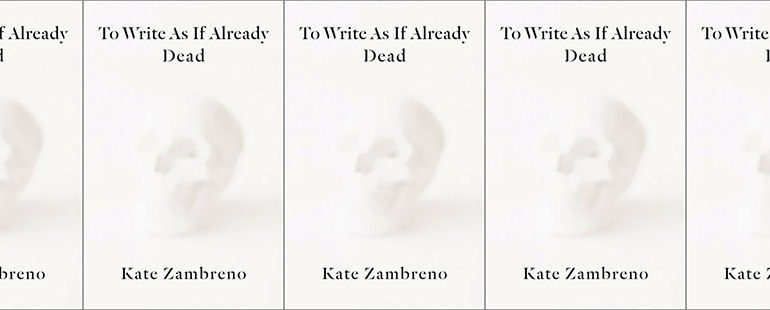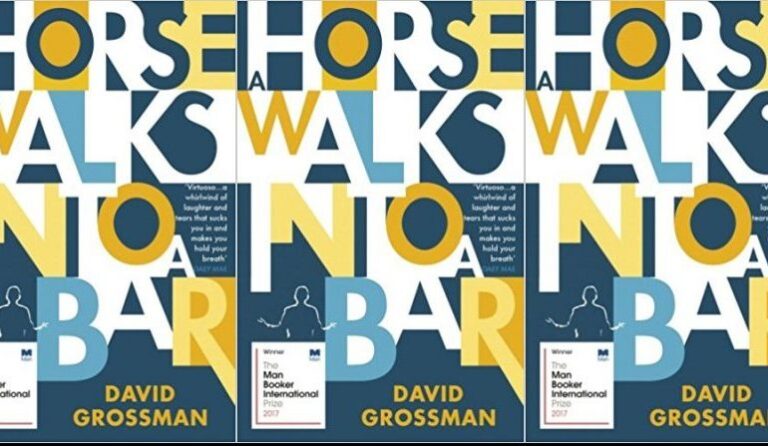Authorship and Betrayal in To Write As If Already Dead

This month I read Kate Zambreno’s latest book, To Write As If Already Dead. I mostly read in the mornings at the table that in my childhood was our kitchen table and now is my family’s dining table, placed at one end of the living room of our Brooklyn apartment, next to the kids’ Lego collection. I worked at that table more often than at my desk during this past year’s months of remote schooling so that I could keep an eye on my third grader, and by mid-morning most days my attention had been shredded in my attempts to keep him on task. But the distractions by my distractible son do not explain why I could read only about ten pages of Zambreno’s book at a time; rather, I found myself overwhelmed by a queasy excitement that I did not understand until I listened to Maris Kreizman’s interview of Zambreno on The Maris Review podcast, in which Zambreno says that in Drifts, her previous book, she thinks she was “trying to pay tribute to a very intensely referential mind,” thus creating “a work that’s like a library of the mind.” I realized I was reminded of the queasiness I used to feel walking along the stacks of the public library of my hometown (which I’ve written about before)—queasy with the desire to read more than I possibly could ever read in a lifetime.
To Write As If Already Dead is formally a diptych. Part I, titled “Disappearance,” is a novella in which the narrator explores the loss of a friendship that had developed almost entirely through correspondence with a writer identified only by a heteronym, Alex Suzuki. Part II, titled “To Write as if Already Dead,” is a study of the 1990 novel To the Friend Who Did Not Save My Life, by French photographer and writer Hervé Guibert, interwoven with passages about the narrator’s experience of a pregnancy and COVID-19 in Brooklyn. Given its fragmented structure, intertextuality, quotations from and reflections on correspondences, and inclusion of the narrative of a pregnancy, the book feels like a companion to Drifts—another “library of the mind,” this one encompassing texts on reading, writing, authorship, friendship, betrayal, the body, birth, and death.
“At what point does the writing become an act of betrayal?” asks the narrator in Part I regarding her friendship with Alex Suzuki, a writer known by a different name in both her everyday life and in the world of small press publishing. The narrator—Kate Zambreno—and Alex Suzuki became correspondents and friends about a decade ago, when each had a literary blog. In an email introducing herself to Zambreno, Alex Suzuki explained that she “blogs and comments on a handful of other blogs under another name in order to attempt to have sincere, authentic conversations about literature.” Because Alex Suzuki had invented her alternative identity “in order to kill off her public author persona,” the narrator wonders if by writing about this friendship, she is betraying that friend. “A poem is a personal exchange, a meeting and an agreement, a point of contract, and more than anything an act of trust. . . . And she has found that trust is the most difficult thing to sustain in the professional literary world, where there is so much competition, careerism, and backstabbing,” the narrator says, summarizing some of what Alex Suzuki writes in her first email to Zambreno. “I know when she wrote me this confession, in this first email, she was asking me not to betray her,” the narrator continues.
Who is Alex Suzuki? Presumably, I could identify “the alter-Alex Suzuki”—the writer behind the heteronym—based on some of the details in the novella: her membership in a particular group of experimental writers, the description of her first book, quotations from a Goodreads account. “Disappearance” is a story, though—autofiction, not an essay—so for all I know “Alex Suzuki” might not even be the heteronym the writer actually used in her correspondence with Zambreno. I don’t care to seek her out. Why would I? I suppose there might be a thrill in uncovering what has been partially hidden, but what would I learn by doing so? All that really matters to me here is what Zambreno’s narrator has to say about the relationship.
Among what the narrator says about the relationship is that when she and Alex Suzuki eventually met in person, it appeared that their friendship did not exist: “In person, neither of us had much to say to the other. There was none of the intimacy that I immediately experienced with others when we first met in person.” And yet, all these years after the relationship ended, the narrator finds an affinity with her former correspondent; she observes that now that she has “become a minor figure in the professional literary world,” her feelings about writing and publishing a book are like those that Alex Suzuki once expressed in an email: “I feel frustrated and inadequate when I think I’m not getting what I expect from the book (attention, sales, readers, influence, etc) but then I think of a few instances where I really feel that I was saying something with the book, something that could in fact reach readers and give them something—and I’ve gotten a few messages of validation that this message was received—and I actually feel content.” “I understand more the existential malady of writing a book and then desiring to disappear from it,” the narrator says. The title of Zambreno’s book is in part a reference to this “malady”; it is based on a quotation of Marguerite Duras that Alex Suzuki once paraphrased: Maybe writers should write as if they were already dead.
Who is this “I” speaking on the page, and what is their relationship to the writer who wants to disappear from the page? As a teacher and as a poet who often writes out of my life, I spend a lot of time thinking about the “I” on the page. I tell my students that the “I” on the page is a persona—a mask, under the cover of which we feel liberated to speak truthfully. Zambreno, quoting Alex Suzuki, writes, “Doesn’t the very act of becoming an author amount to the creation of a public persona apart from one’s personal self? And yet literature itself is where the truest things can be said.” One can disown the “I” on the page—that “I” is not me, it was never me, it is no longer me—because the “I” is a character, not the self. But to draw another character from life (a family member, a friend) and reveal truths through that character is much trickier business.
Betrayal is the thematic thread connecting the story of Zambreno’s friendship with Alex Suzuki to the study of Guibert’s novel in Part II of To Write As If Already Dead. To the Friend Who Did Not Save My Life is an account of the narrator’s experience of being diagnosed with AIDS, and it is infamous for having revealed AIDS as the actual cause of the death of his friend and mentor Michel Foucault. “Was it a betrayal to write about his friend in his most private moments—the moment of his disintegration and death?” asks Zambreno, identifying the exposure of the vulnerability of his friend (called “Muzil” in the novel) as Guibert’s greatest betrayal: “How vulnerable Muzil appears, in the hospital room smelling of fried fish, without his trademark glasses, with that tender detail of the bit of dried blood on the back of his head from the fall that landed him in the hospital, with his exhaustion and wracking cough, with his fright at an upcoming spinal tap.” How unlike this fragile, frightened “Muzil” the public persona cultivated by Foucault is, with his bald head, black turtleneck, wire-rimmed spectacles.
“Yes it’s awful but it’s the truth,” says Guibert in response to an interviewer’s question about another scene, in which he washes his lips at home after kissing Muzil’s hand. Guibert is shameless in telling what he believes to be the truth; for a collection of his photographs, he once wrote that he saw his photographs of his friends, not his writing about them, as a betrayal: “In my writing there’s no brake on what I do, no misgivings since I’m virtually the only one who counts (other people become abstract characters bearing just initials).” This assertion—I’m the only one who counts—suggests a strong identification between Guibert the writer and the “I” on the page. But he also saw his writing as a kind of purging; in the same interview he says: “I was writing intolerable things. I think I was doing this in order to forget those things because when I write, all of what I write, once it is written, it is forgotten.” In response to a question from Alex Suzuki, Zambreno’s narrator says something similar: “I don’t think I am the narrator. Although sometimes I’m not sure if I’m the author anymore either. After I publish a book I am so emptied out of it, outside of it, I am not sure I even can comment on it. I am not sure who ‘I’ am, really.” I am not sure who “I” am, really: Reading this sentence, I think of how in meditation, my thoughts disintegrate almost as soon as they arise—and the relief of that, sometimes.
I no longer remember very much of what I read of Foucault so long ago. When I glance through the entry on him in Wikipedia, I am reminded that his central concern was the relationship between knowledge and power, and I think of the powerlessness of the dead, how the dead cannot prevent us from knowing them in any particular way. I regret that I do not know more of Foucault or of many of the other writers mentioned in the book—libraries are filled with books I have not read—and in response to the narrator’s description of Alex Suzuki as someone “who had read a lot of critical theory, judging from the way jargon sometimes cluttered her language,” I write in my notes, “I read naively—no clear sense of my own theory of reading.”
A few days later, while on a run through my neighborhood, I realize that I do in fact have a theory of reading, grounded in reader-response theory, which I learned about when I was in graduate school at Teachers College. I often tell my writing students, à la Louise M. Rosenblatt, that the poem exists not on the page, but in the relationship (Rosenblatt uses the word “transaction”) between text and reader. I am reminded that at the beginning of To Write As If Already Dead Zambreno’s narrator, remembering the gallery at the Met where Manet’s paintings are hung, says, “The museum has been closed now for months. I think of the paintings hanging there alone, with no one to gaze at them. Are they covered over, like a shroud?” Reader-response theory is a close cousin to the poststructuralism of Foucault and Roland Barthes, who so famously wrote about the death of the author. “Barthes wants to kill the author, Foucault wants the author to take on the appearance of a dead man,” writes Zambreno’s narrator, and on my run I conclude that I want nothing of the sort. Both reading and writing are for me a kind of becoming—a becoming in relationship with others, either on the page or in conversation. My writing can be as provisional—as alive—as my reading of a text, neither ever finally settled. It is when I am not engaged in either, especially when I am not writing, that I begin to feel lonely, desperate, deadened.
The neighborhood I run through is, I think, the neighborhood where Zambreno lives, though I don’t know that I’ve ever seen her. The giveaway is a reference in Drifts to a mechanical horse outside a particular restaurant—I know that restaurant, and I had forgotten about the pink horse that once stood in front of it. There is more that I could say about this neighborhood and how Zambreno writes about it, but I am afraid that to say more would be a betrayal of her. But this much I will say: I am glad (envious, actually) that she has a porch, and that she evidently spends time sitting on it. There are so many unoccupied porches in our neighborhood.


